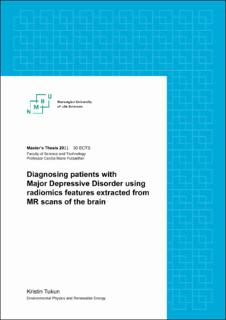| dc.contributor.advisor | Futsæther, Cecilia Marie | |
| dc.contributor.advisor | Nesvold, Jon | |
| dc.contributor.advisor | Tomic, Oliver | |
| dc.contributor.author | Tukun, Kristin | |
| dc.date.accessioned | 2021-12-29T12:45:48Z | |
| dc.date.available | 2021-12-29T12:45:48Z | |
| dc.date.issued | 2021 | |
| dc.identifier.uri | https://hdl.handle.net/11250/2835576 | |
| dc.description.abstract | The main aim of this study was to diagnose patients with major depressive disorder (MDD) using structural T1 weighted images of the brain. The images originate from the DELHI study conducted in the Netherlands from July 2005 to February 2007. 21 images of patients diagnosed with MDD and 22 images of healthy controls were received. Patients and controls were scanned at study entry referenced to as t0. The patients were administered the antidepressant paroxetine and scanned again at 6 and 12 weeks, referenced as timesteps t1 and t2. Further, the images were sent to an application programming interface (API) called RadiomPipe that segmented the images into masks of brain regions and extracted radiomics features. The outputfrom RadiomPipe was a high dimensional dataset that consisted of 10165 radiomics features.
This study mainly focused on the dataset containing radiomics features ofpatients and controls at study entry, t0. The samples were split into a train-ing and test set three times stratified by whether the individual belonged to the patient class or the control class. The Repeated Elastic Net Technique(RENT) algorithm was applied to each of these splits to reduce the numberof features in the dataset by training an ensemble of 100 elastic net regularized models and selecting features by evaluating the weight distributions of features across the models. The first split selected eight features while the two other splits selected seven features. Further, the ensemble of models predicted the diagnosis of patients with high accuracy over all three splits.The high accuracies indicated that the RENT model was a robust model that potentially can perform well on new data.
A Principal Component Analysis (PCA) was conducted with the featuress elected by RENT for each split. The PCA showed that it was possible to separate the patient and control class using only the features selected by RENT for each split. In total RENT selected 14 features across the splits. Four of these featureswere selected by every split.
A PCA was applied to the dataset containingthese four features, which showed that the patient and control classes could be separated. These four features corresponded to the brain region right medial orbital gyrus. Given that all three splits found the right medial orbital gyrus useful to predict MDD diagnosed patients, it may be considereda possible neural biomarker. | en_US |
| dc.language.iso | eng | en_US |
| dc.publisher | Norwegian University of Life Sciences, Ås | en_US |
| dc.rights | Attribution-NonCommercial-NoDerivatives 4.0 Internasjonal | * |
| dc.rights.uri | http://creativecommons.org/licenses/by-nc-nd/4.0/deed.no | * |
| dc.title | Diagnosing patients with Major Depressive Disorder using radiomics features extracted from MR scans of the brain | en_US |
| dc.type | Master thesis | en_US |
| dc.description.localcode | M-MF | en_US |

